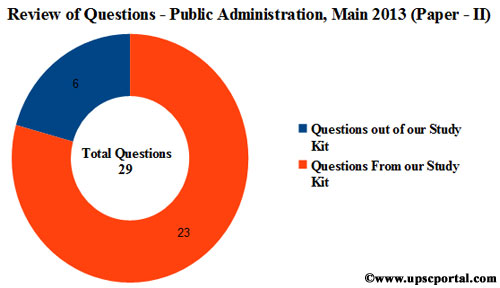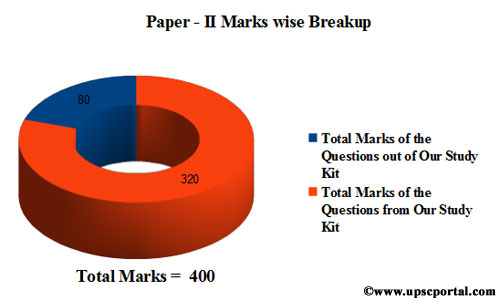(Questions Review) Public Administration, Main 2013 (Paper - II)
Review of Questions - Public Administration, Main 2013 (Paper - II)
UPSC comes with new word limits here: 10 marks = 150 words and 20 marks = 250 words. There is one question worth 30 marks- but word limit not mentioned. Each Paper (I and II) with 250 marks and 3 hours’ time limit.
The Question Paper remains same like earlier (before 2013) i.e.
- Eight Questions in two sections (A and B)
- Candidate has to attempt five questions.
- Question No. 1 and 5 are compulsory.
- Out of the remaining, pick any three- but choose at least one from each section.
Total Time 3 Hours Total Marks 250
Question Paper Specific Instructions
-
Please read each of the following instructions carefully before attempting questions:
-
There are EIGHT questions divided in two SECTIONS and printed both in HINDI and in ENGLISH.
-
Candidate has to attempt FIVE questions in all.
-
Questions no. 1 and 5 are compulsory and out of the remaining, THREE are to be attempted choosing at least ONE from each section.
-
The number of marks carried by a question/part is indicated against it.
-
Answer must be written in the medium authorized in the Admission Certificate which must be stated clearly on the cover of this Question-cum-Answer (QCA) Booklet in the space provided. No marks will be given for answer written in a medium other than the authorized one.
-
Word limit in questions, wherever specified, should be adhered to.
-
Attempts of questions shall be counted in chronological order. Unless struck off, attempt of a question shall be counted even if attempted partly. Any page or portion of left blank in the answer book must be clearly struck off.

Section A
Question 1 (Compulsory)
Attempt following about 150 words each. 10 marks x 5 = 50m
1. The charter act of 1853 marked the beginning of parliamentary system in
India. Explain
(This question from our
Public Administration Study Kit of Paper II-Chapter-1-
Page No-11 to 13)
2. Civil service neutrality is founded on the application of the principles
of rule of law. Comment
(This question from our
Public Administration Study Kit of Paper II-Chapter-8-
Page No-252 to 253)
3. The second generation reforms in Panchayati Raj institution have changed
Panchayats from an agency of Development at local level into a political
institution. Comment
(This question from our
Public Administration Study Kit of Paper II-Chapter-11-
Page No-295 to 296)
4. Finance commission in India performs the job of statistics aggregation.
Comment
(This question from our
Public Administration Study Kit of Paper II –
Chapter-6-Page No-183 to 185)
5. Planning enables comprehensive and scientific understanding of problems.
Examine the statement in context of planning methodology.
(General question need understanding based on common sense-Chapter-5-Read
concept of Planning thoroughly)
Question 2
1. Bureaucratic agencies, characterized by established procedures,
specialization, leadership, clean objectives, are not ideal to handle disaster
Management. examine with reference to the need for Administrative flexibility in
managing disasters. (20 marks | 250 words)
(This question from our
Public Administration Study Kit of Paper II –Chapter-14-
Page No-358)
2. The liberal -democratic ideology of the west influenced in shaping of
value premises of the Indian Constitution. Discuss. (20 marks | 250 words)
(This question from our
Public Administration Study Kit of Paper II-Chapter-2-
Page No-19 to 24)
3. Autonomy to public sector undertakings is a myth. Analyze in the context
of the use of government Expenditure by politicians to control governments at
different levels. (10 marks | 150 words)
(This question from our
Public Administration Study Kit of Paper II-Chapter-3-
Page No-49)
Question 3
1. Laws are enacted without involving police in the conception stage, with
the result implementation of these laws leaves much to be desired. Examine the
role of police in protection of children. (10 marks | 150 words)
(This question from our
Public Administration Study Kit of Paper II –
Chapter-13-Page No-285 to 286)
2. Central Secretariat is the nodal agency for administering the union
subjects and establishing coordination among the various activities of
government discuss. (20 marks | 250 words)
(This question from our
Public Administration Study Kit of Paper II – Chapter-4-Page No-127 to 128)
3. Is there is need to dispense with the office of the governor? Examine in
the context of coalition governments. (10m | 150w)
(This question from our
Public Administration Study Kit of Paper II –
Chapter-6-Page No-185 to 186)
Question 4
1. “There is a tendency of centralism in Indian federalism, but it is not
because of its institutional framework but because of its socialist goals and
centrally devised plan development.” explain the statement in the context of
union-state relationships (20m|250w)
(This question from our
Public Administration Study Kit of Paper II –Chapter-6-
Page No-176)
2. Use of information and communication technology in Panchayat’s function
enhances efficiency, transparency and accountability and also induces mass ICT
culture. Examine (20m|250w)
(This question from our
Public Administration Study Kit of Paper II –Chapter-11-
Can be attempted through our ‘e-governance’ notes of kit)
3. Judicial review of administrative tribunal’s decision defeats the very
objective of establishing tribunals. Comment with reference to central
Administrative tribunal. (10m|150w)
(This question from our
Public Administration Study Kit of Paper II-Page
No-111 to 113)
Section B
Question 5 (Compulsory)
Attempt following about 150 words each. 10 marks x 5 = 50m
1. Public Administration today tends to be less of public in quantitative
terms, but more responsive to public needs than before in qualitative terms.
Examine with reference to citizen centric administration
(This question from our
Public Administration Study Kit of Paper II-
Chapter-14-Page No-346 to 349)
2. Performance budgeting failed because it was applied to sectors/ programs
where quantitative evaluation was not feasible. Examine the principles
underlying performance budgeting techniques.
(This question from our
Public Administration Study Kit of Paper II- Page
No-208 to 209)
3. The design of the Indian police was to subjugate the Indian people in the
aftermath of 1857. Analyze in the context of Indian police Act of 1861.
(This question from our
Public Administration Study Kit of Paper II-Chapter-13
Page No-312)
4. Reducing the size (geographical area) of the district will provide relief
to the overburdnened and overworked collector. Comment
(This question from our
Public Administration Study Kit of Paper II-Chapter-7-
Page No-220)
5. The concept of social audit is more comprehensive than that of traditional
audit. Comment
(This question from our
Public Administration Study Kit of Paper II- Page
No-102 to 105)
Question 6
1. Gandhian model of decentralization is similar to the process of
reinventing governance. Analyze in the context of good governance. (20m|250
words)
(Relate Gandhian model of decentralization and concept of good governance-Chapter-11)
2. Accounting is the essence of producing promptly and clearly the facts
relating to financial conditions and operations that are required as a basis of
management. Substantiate the statement in the context of accounting methods and
techniques in government (20m|250 words)
(This question from our
Public Administration Study Kit of Paper II-Chapter-9-
Page No-265 to 266)
3. Explain the important recommendations of VT Krishanamachary Committee
(1952) on the Indian and State Administrative services and problems of district
administration. (10m|150w)
(For this question visit upscportal website-Chapter-8)
Question 7
1. The 73rd amendment, it is felt, may accentuate fiscal indiscipline by
establishing between states and local governments a system of transfers, similar
to the one in place between central and state government (world bank) Comment
(20m|250w)
(This question from our
Public Administration Study Kit of Paper II –
Chapter-11-Page No-293 to 295)
2. Municipal administration in India faces both structural and operational
challenges. examine in context of the post 74th amendment act (20m|250w)
(This question from our
Public Administration Study Kit of Paper II –
Chapter-12-Page No-302 to 304)
3. Self-help groups (SHG) have contributed to a change in the role of rural
women in development from symbolic participation of empowerment (10m|150w)
(This question from our
Public Administration Study Kit of Paper II - Page
No-131 to 132)
Question 8
1. There is both criminalization of politics and politicization of criminals
in India . Examine and identify the challenges they cause for law and order
administration. (20m|250w)
(This question from our
Public Administration Study Kit of Paper II –Chapter-13-
Page No-323 to 325)
2. The basic ethical problem of an administrator is to determine how he/she
can use discretionary power in a way that is consistent with democratic values.
comment with reference to corruption in administration (20m|250w)
(This question from our
Public Administration Study Kit of Paper II –
Chapter-14-Page No-349 to 353)
3. Justify the Constitutional provisions to treat certain expenditure as
charged upon Consolidate fund of India (10m|150w)
(Purely Constitutional question, Refer D D Basu-Chapter-9)
Paper II- Marks wise Breakup

Paper II- Chapter wise Breakup
Indian Administration
-
Evolution of Indian Administration:- 1 Question- 10 Marks
-
Philosophical and Constitutional framework of government:- 1 Question- 20 Marks
-
Public Sector Undertakings:- 1 Question- 10 Marks
-
Union Government and Administration:- 1 Question- 20 Marks
-
Plans and Priorities:- 1 Question- 10 Marks
-
State Government and Administration:- 3 Questions- 40 Marks
-
District Administration since Independence:- 1 Question- 10 Marks
-
Civil Services:- 3 Questions- 30 Marks
-
Financial Management:- 5 Questions- 50 Marks
-
Administrative Reforms since Independence:- No Question Asked
-
Rural Development:- 5 Questions- 80 Marks
-
Urban Local Government:- 1 Question- 20 Marks
-
Law and Order Administration:- 3 Questions- 50 Marks
-
Significant issues in Indian Administration:- 3 Questions- 50 Marks
IAS MAINS-PUBLIC ADMINISTRATION Online Coaching DEMO
-
IAS MAINS-PUB AD Chapter Demo
-
IAS MAINS-PUB AD Home Assignments Question Demo
-
READ BATCH-1 SCHEDULE
-
Live Chat DEMO
-
Discussion Forum Demo
CLICK HERE TO JOIN FULL ONLINE COACHING FOR PUB AD
CLICK HERE TO BUY PUBLIC ADMINISTRATION STUDY KIT IN HARD COPY
